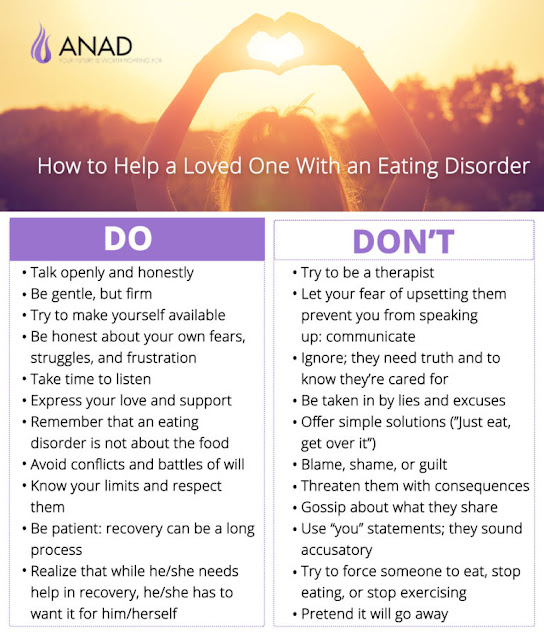Eating Disorder
"Every 62 minutes at least one person dies as a direct result from an eating disorder"In the U.S. alone, there are at least 30 million people who suffer from having an eating disorder (ED). It also has the highest mortality rate of any mental illness. And, genetics, environmental influences, and personality traits all have the ability to create risk for a potential eating disorder. One of the most understudied areas in regards to eating orders is the environmental influence on gene expression for anorexia nervosa (AN), bulimia nervosa (BN) and eating disorders not otherwise specified (EDNOS). Environmental factors associated with nutrition and stress can cause epigenetic changes and, therefore, cause transcriptional and phenotypic effects, which could play a role in the development of an eating disorder.
There are a significant amount of risk factors that have been identified in AN, BN, and EDNOS. Some of these risks are: Childhood feeding and sleeping problems, over-anxious parenting, sexual abuse, perfectionism, etc.. It can therefore be seen that early environment has a great influence on the risk factors associated with the onset of an eating disorder. So, it is important to then ask, what role do these factors have on the mechanisms that produce an epigenetic change in response to gene expression for ED?
A critical epigenetic mechanism, histone modification, ultimately affects chromatin structure (DNA + protein) due to methylation (process in which a methyl group, or multiple methyl groups, will bind to an amino acid and either activate or repress gene expression) and acetylation (an acetyl group added to a lysine on the N terminus of histone proteins; this allows for RNA polymerase to have access to the promoter, initiating gene expression) of lysine residues. Activation of this mechanism will ultimately allow for gene expression during development. It has been found that metastable epialleles (alleles that are variably expressed in genetically identical individuals due to epigenetic modifications that were established during early development (Dolinoy et al., 2007)) are loci (position of a gene on a chromosome) that can be modified epigenetically, for they are environmentally sensitive to maternal stress, behavior and diet prenatally, which then leads to the risk of an eating disorder to be developed. It has been found that individuals who have eating disorders and obesity show DNA methylation in fat cells that lead to gene expression in relation to calorie restriction (Bouchard et al., 2010).
The environment that a fetus is exposed to in utero has a significant impact on the potential of developing an eating disorder. It is shown that if the fetus is exposed to maternal stress in the womb, along with a poor developmental environment and compromised metabolism, the epigenetic changes that affect gene expression in the fetus could be long term. The significance of these findings indicate the importance of how environmental effects could alter the expression of traits in relation to eating disorders, such as: appetite, weight, and energy. These traits could potentially be altered during adulthood due to a response to varying environmental influences. Therefore, there are specific genes that help to identify those in relation to fat mass and obesity (FTO), leptin, and POMC and BDNF. These genes allow for further research to see if they are responsible for risk in an individual due to epigenetic modification.
- There is a 70% increased risk of obesity for individuals who have two copies of a polymorphism in the FTO gene.
- Epigenetic changes to FTO in association with DNA methylation could change an individuals desire to binge eat; resulting in bulimia nervosa and binge eating disorder.
- Leptin gene is in relation to energy storage and how that energy is utilized. The leptin promoter contains sites of cytosine methylation, which in turn could produce epigenetic regulation of this gene. This regulation is due mostly during development, due to set point of where energy homeostasis is defined in the fetus.
- It has been shown that methylation to the promoter of POMC gene show results in an individual to be underweight and also produce addiction like behaviors; cravings found in those who have bulimia nervosa and binge eating disorder.
- BDNF affects neural development and regulates a specific neuronal histone; therefore, it could be linked with eating disorders due to histone modification .
Using these genes as candidates to determine eating disorder risk due to epigenetic modification ultimately show that neuronal development, stress, and cravings are components that are greatly influential in this process.
There is substantial evidence that can link the development of an eating disorder to exposure in relation to poor nutrition and stressors that act to promote epigenetic changes that are critical in life due to expression seen in adulthood caused by a change in environment.
It through the hopes of obtaining better understanding of this biological process in response to eating disorders that effective preventative measures and therapeutic intervention can be greatly implemented for the future. Many who suffer from ED are a severely silenced population of individuals who deserve attention to highlight the significance of those working to overcome this disorder.
If you know a loved one who is struggling, here are ways in which you can be there for them:
visit http://www.anad.org/ for more information.
References:
1. Bouchard, L., Rabasa-Lhoret, R., Faraj, M., Lavoie, M., Mill, J., Perusse, L., & Vohl, M. (2009). Differential epigenomic and transcriptomic responses in subcutaneous adipose tissue between low and high responders to caloric restriction. American Journal of Clinical Nutrition, 91(2), 309-320. doi:10.3945/ajcn.2009.28085
2. Iain C. Campbell, Jonathan Mill, Rudolf Uher, Ulrike Schmidt, Eating disorders, gene–environment interactions and epigenetics, In Neuroscience & Biobehavioral Reviews, Volume 35, Issue 3, 2011, Pages 784-793, ISSN 0149-7634, https://doi.org/10.1016/j.neubiorev.2010.09.012.

Comments
Post a Comment